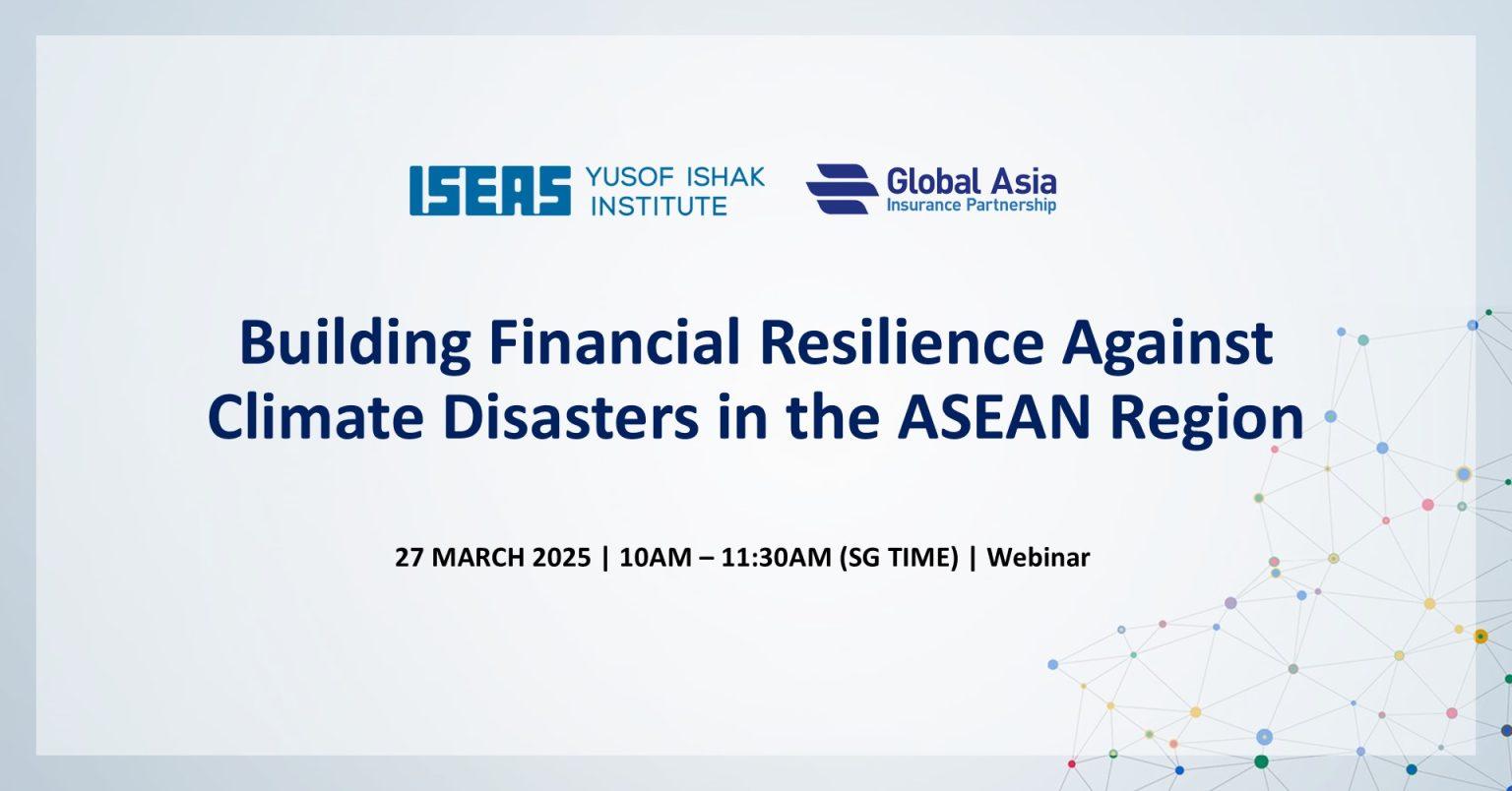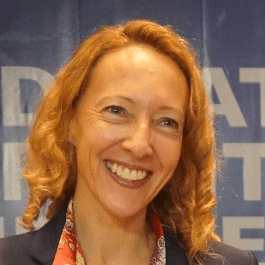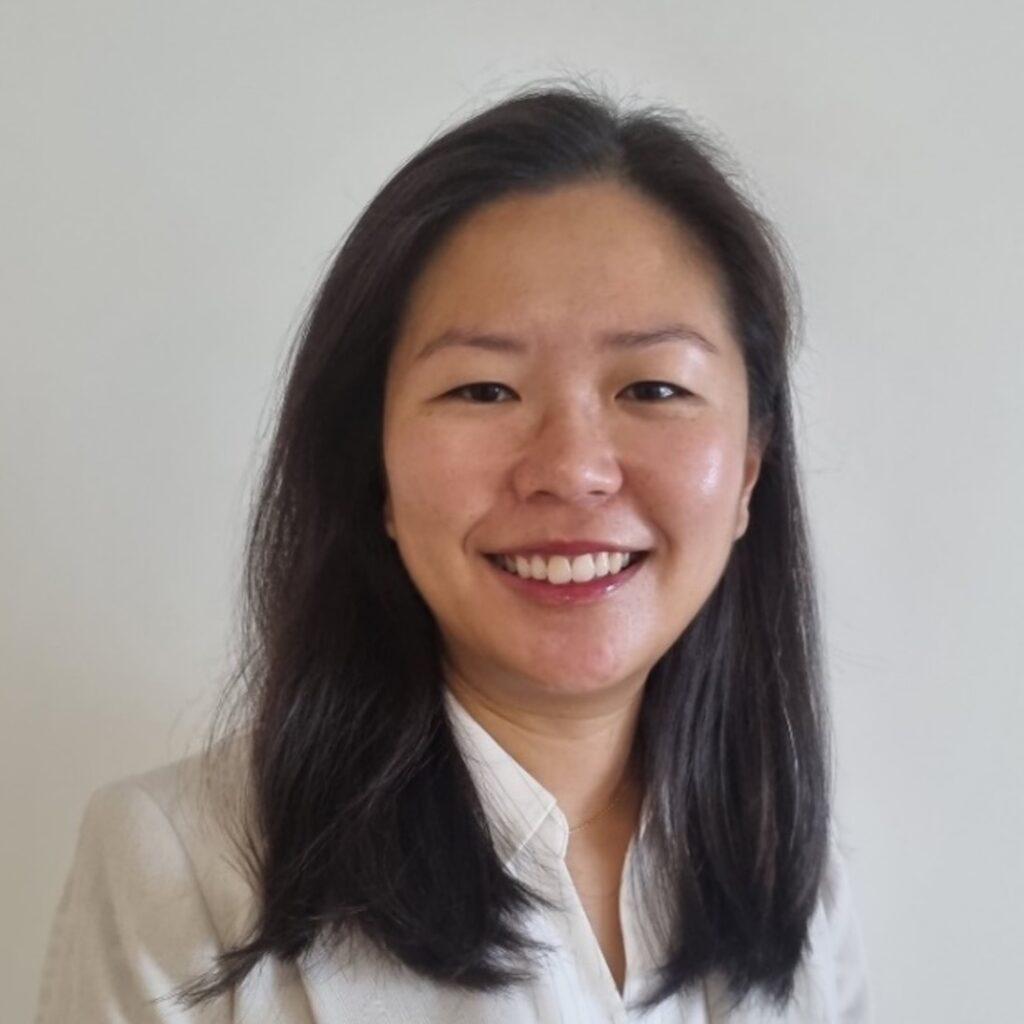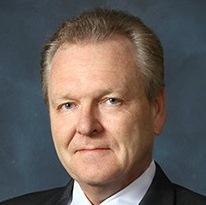
27 MARCH 2025, 10:00 – 11:30 (SGT)
Southeast Asia is among the world's most vulnerable regions to climate risks, driven by its dense population, rapid economic growth, and accelerated urbanization. The region also faces a significant protection gap—the disparity between economic losses caused by unforeseen or undesired events and the amount covered by insurance or other risk financing mechanisms. As climate risks intensify, these gaps are becoming more pronounced, threatening the financial resilience of individuals, businesses, and governments. Without effective risk financing solutions, unexpected disasters can quickly derail economic stability and long-term development. To safeguard ASEAN's economies and communities from the escalating impacts of climate change, it is essential to close these protection gaps.
Co-hosted by the Climate Change in SEA programme of ISEAS – Yusof Ishak Institute and the Global Asia Insurance Partnership (GAIP), this webinar will bring together experts in risk perception, disaster risk financing, and insurance to explore how ASEAN can enhance climate risk preparedness. Speakers will assess the region's readiness to manage growing climate risks, examine lessons from past initiatives, and highlight different financial protection strategies in strengthening resilience. The session will also explore emerging opportunities for governments, insurers, and financial institutions to collaborate in narrowing protection gaps and building long-term climate resilience.
On the panel:
Summary:
Dr Olivia Jensen, Deputy Director and Lead Scientist for Environment and Climate of the Lloyd's Register Foundation Institute for the Public Understanding of Risk (IPUR) at the National University of Singapore, Ms Ellen Yong, Chief Operating and Financial Officer at SEADRIF Insurance Company, and Mr Craig Thorburn, Consultant for the Global Asia Insurance Partnership (GAIP), shared insights from their respective fields of expertise in public perceptions of risk, regional disaster insurance operations and public sector roles in disaster resilience.
Each speaker provided a different perspective on challenges and opportunities faced by the region in preparing for climate disasters. The session was moderated by Dr Christopher Len, Senior Visiting Fellow and Co-Coordinator at the Climate Change in Southeast Asia Programme at ISEAS.
Dr Jensen began by introducing her institute, the IPUR, where she conducts research on individuals' understanding of risk and how perceptions of risk can be shaped to guide individuals towards more informed decisions. Noting that risk perceptions are subjective, context-sensitive and have important personal, social, political and economic implications, she shared four main insights from a global survey on climate risk perceptions. Firstly, people in ASEAN are less worried about climate change but better prepared for extreme weather compared to those in other regions. This could be due to the historical prevalence of extreme weather in the region. Secondly, for areas like Japan and Singapore, flooding is perceived as a risk but considered relatively low priority when compared to other urban risks such as heat waves, typhoons and air pollution. Thirdly, people are taking action to prepare themselves for disasters, and community involvement can help drive such actions.
In comparison, the level of trust in government to protect the population had different effects on disaster preparations in different countries. In Vietnam and the Philippines, people were more likely to take individual action if they had higher levels of trust. In Singapore, the reverse was true: those who trusted the government to take action were less likely to take action themselves. Fourthly, people may be willing to pay more for flood risk management projects if they are effective and avoid negative biodiversity impact. This is seen in the example of Singapore's proposed Long Island project which aims to reduce coastal flood risk, where Singapore respondents were willing to pay an average of $26 per month if the project provided high flood protection and up to $13 per month for avoiding habitat loss.
Ms Ellen Yong continued by introducing the Southeast Asia Disaster Risk Insurance Facility (SEADRIF), an ASEAN+3 initiative to provide ASEAN countries with insurance and technical support for strengthening financial resilience against disasters and climate shocks. Under this mandate, the SEADRIF Insurance Company develops financial products, provides risk finance support such as transaction advisory, supports public goods such as training and data and facilitates the exchange of best practices and innovations. She shared that the region faces unique challenges due to the wide diversity in perils faced, geographical traits and the availability of insurance products, making it difficult to design a one-size-fits-all solution.
ASEAN countries sit at different stages of public insurance programme development, which could hinder the implementation of a regional insurance strategy. Domestic insurance markets vary in maturity level, which is a barrier to scaling insurance products across the region. This is exacerbated by the unique regulatory environment and procurement processes that must be navigated in each country. Lastly, building trust and coordination among countries and with international partners can be challenging; political difficulties can arise in the implementation of joint programmes due to differing national interests. However, there are common gaps and needs that can drive regional collaboration, such as expanding insurance coverage cost-effectively, reducing transaction costs, accessing data, expertise, technology, reinsurance capacity, and premium affordability.
As such, a regional risk pool such as SEADRIF can provide many benefits including: (a) reduced costs through risk diversification, economies of scale and strengthened negotiating power; (b) budget and price stability via smoothed insurance prices over insurance cycles, and c) increased access to expertise, testing and new technologies. In one case study, it was estimated that earthquake premiums could be 16% lower with a regional risk pool through diversification alone, compared to a scenario where countries purchased insurance individually. Ms Yong went on to share about SEADRIF's Lao Parametric Flood Insurance Product as an example of its work. In 2023, it successfully paid out the Lao government's claim just one business day after it was submitted, thus providing rapid support to recovery efforts.
Mr Thorburn introduced his organisation, GAIP, a tripartite partnership that brings together the global insurance sector, regulators and policymakers, and academia to build long-term risk resilience in Asia, through in-depth research, policy development, and talent building. He introduced the concept of protection gaps, which are defined as the disparity between economic losses caused by unforeseen or undesired events and the amount covered by insurance or other risk financing mechanisms. Of this protection gap, the insurable gap can be further split into (i) gaps where insurers do not have the capacity to insure and (ii) gaps where insurers have the capacity to insure but are not reaching the correct audience. Against this backdrop, Mr Thorburn shared that the region's protection gap is widening. To address this, GAIP has identified several key problems through a comprehensive analysis of policies, solutions and media coverage. First, different sectors are operating in silos, with little cooperation. Next, although many solutions are being applied effectively in Asia, they remain limited in scale. Such solutions need to be expanded through stronger and more transparent government mandates across multiple sectors, for example, agriculture, finance and social security. In addition, the region lacks country-level data, which GAIP is working to develop. Finally, GAIP observed that decision-making is not being driven by cost-benefit analyses.
To address these issues, Mr Thorburn advocated for a holistic approach that involves all relevant government agencies, rather than restricting control to one agency. He argued that doing so could allow governments to consider risks across multiple sectors; raising the example of the Sustainable Development Goals, wherein many goals can be positively affected by strengthened risk resilience. Moreover, the impacts arising from poor disaster preparedness have cascading effects on the wider economy, such as reduced GDP and unemployment, thus calling for the attention of bodies like the Ministry of Finance. Finally, Mr Thorburn explained how leveraging the interactions between three different solution types: risk reduction, increasing insurance penetration, and fiscal risk financing, can lead to a virtuous cycle of resilience growth. For instance, risk reduction through disaster preparedness can reduce the fiscal burden on governments when disasters occur while increasing insurance penetration by improving affordability and accessibility. The increased insurance penetration, in turn, reduces the risk exposure for the government. Compared to a traditional approach of having only the public sector implement risk financing and risk reduction, the involvement of insurance through a public-private partnership can further incentivise risk reduction and extend the effects of these solutions.
During the Q&A session, the panellists responded to one another's presentations and addressed questions on the importance of public-private partnerships, co-benefits of disaster preparation, and challenges in regional cooperation on disaster risk financing. The webinar drew an audience of almost 110 participants, with over 160 registered.


